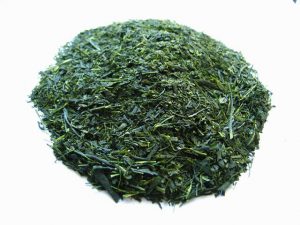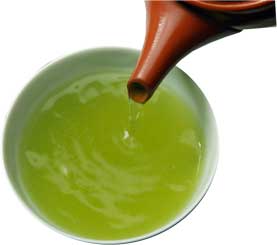 Saemidori (さえみどり), meaning “clear green”, is a cultivar that produces a bright green liquor.
Saemidori (さえみどり), meaning “clear green”, is a cultivar that produces a bright green liquor.
It seems to be getting more popular among Japanese tea farmers, although it has still a long way to go.
Suitable for warm climates, it’s mainly cultivated in the Kyushu region of southern Japan, especially the prefecture of Kagoshima.
Saemidori, being an early-budding cultivar, can be harvested 4 to 7 days earlier than Yabukita.
History of Saemidori
As explained in the previous post, the Asatsuyu cultivar is of high quality but the quantity at harvest is low, plus it’s very weak against frost. To remedy this, Asatsuyu was crossed with Yabukita in 1969.
Saemidori was finally registered in 1990 as tea cultivar number 40, meant for sencha production. However, it’s now also used for fukamushicha and gyokuro.
Characteristics of Saemidori
 The color, aroma, and taste of brewed Saemidori are very good, even at later flushes. It has a higher amino acid content than Yabukita, although the “natural gyokuro” property of Asatsuyu isn’t there.
The color, aroma, and taste of brewed Saemidori are very good, even at later flushes. It has a higher amino acid content than Yabukita, although the “natural gyokuro” property of Asatsuyu isn’t there.
This cultivar has a yield similar to Yabukita, but although reasonably resistant to some diseases, it’s very weak against others.
Saemidori is susceptible to frost damage, and once this happens it doesn’t recover easily. Thus, in colder regions there must be measures set in place.
Another thing to keep in mind is that the leaves of young Saemidori tea plants can be blown away by strong wind, which will impede their growth.
As a drink, Saemidori compares favorably with both Yabukita and Asatsuyu. It’s a successful hybrid, and worth a try for Japanese tea lovers.

December 18, 2013
As always, great information, Ricardo 🙂
December 18, 2013
Thank you Griff, I’m glad that you liked this post.
March 23, 2016
[…] friends who are. Specifically, Ricardo Caicedo of the My Japanese Green Tea blog; he actually did an extensive write-up on the saemidori […]
April 22, 2017
I’ve always seen cultivar names like Saemidori and Yabukita on Japanese teas but never understood what they meant. Thank you for the informative and well written article!
April 22, 2017
Dear Ali, thank you very much for reading. I’m glad that you learned about Japanese tea.
June 24, 2018
Thanks a lot, Ricardo! Excellent website for tea lovers and so much to learn..
Many greetings from Berlin!
June 24, 2018
Thanks for your comment David.
Let’s keep learning about Japanese tea together.